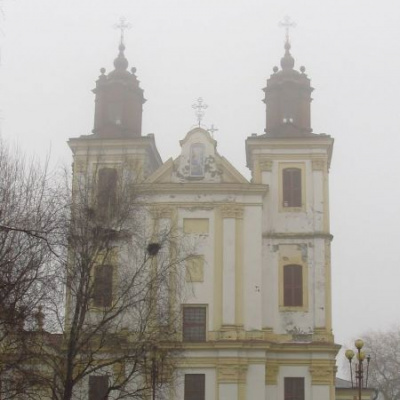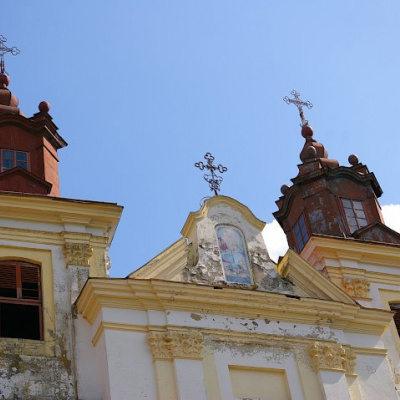Church of the Visitation of the Blessed Virgin Mary (Dominican Monastery), Bohorodchany
TheChurch of the Visitation of the Blessed Virgin Mary is a Roman Catholic church in the village of Bohorodchany, Ivano-Frankivsk region. It is an architectural monument.
The Catholic church was founded in Bohorodchany in 1691 at the expense of K. Potocka. The first church was wooden. In 1742-1762, it was rebuilt into a brick church, and a complex with clergy chambers, a fence, and a gate was built. The complex was heavily damaged during the First World War. The Baroque religious building has retained its architectural authenticity to this day. The miraculous icon of the Mother of God was kept in the Bohorodchany church, which was taken to Poland in 1944. The Orthodox Church of Peter and Paul (transferred to the OCU on February 3, 2019) operated in the church building, and a music school was housed in the chambers.
The first written mention of the village of Bohorodchany, known since the beginning of the fifteenth century, whose main occupation was weaving and tailoring, dates back to 1441. It mentions the owner of these lands as the starosta of Terebovlia, Ivan from Buchach (1400-1454), although his rule here was not very long - in a few years the settlement was in the hands of the powerful Potocki family.
The Orthodox faith has long been dominant in Prykarpattia, as evidenced by the documentary mention of a priest in the local tax registers from 1515, which confirms the presence of a church of some kind in the village. It was granted the status of a city only in 1631.
The growing influence of Catholicism began with the adoption of the Union of Brest in 1596 at the suggestion of the owners who belonged to the Polish ruling elite, although the first wooden Catholic church was documented to have appeared here only a century later with the light hand of Countess Constance Potocka (née Tysmenytsia), the widow of the grandfather of the keys of Bohorodchany and Tysmenytsia, Dominik Potocki (1646-1683), who recorded a fondue for the construction of a Dominican monastery with a church.
The original church of the Holy Trinity, like the monastery complex nearby, was built of wood and consecrated in 1691. The area around it was quickly settled by small gentry and dozens of artisans who had migrated from Poland. This popularity is explained by the miraculous image of the Virgin and Child, which the first preaching fathers brought with them, being kept within these walls.
Sometime in the first half of the eighteenth century, the Catholic center burned down, although the holy face was saved. The Dominican monastery owes its rebuilding in stone to the son-in-law of the founder of the Dominican monastery, the castellan of Kamin, Stanisław Kostka Kossakowicz, who began construction work in 1742.
After a long period of work that lasted almost two decades, in 1761 the Trinity Church was finally completed, and a year later the clergy chambers were added, creating a quadrangular closed perimeter. The official cosseting of the church took place in 1775 with the solemn return of the crowned icon of the Mother of God of Bohorodchany.
Nothing changed in the life of the monastery, under whose wing and on whose territory a general parish school began to work almost immediately, and after the re-subordination of this part of Bukovyna to the Habsburg crown after the collapse of the Polish-Lithuanian Commonwealth, and after the formation of the Austro-Hungarian Union, a golden rain of its bounty fell on the Carpathian region - in the second half of the complex underwent a large-scale restoration, the greatest sign of which was the new domes of the church towers.
The next reconstruction of the Dominican complex was carried out in 1904-1905 under the direction of the architect Theodor Marian Talewski (1857-1910), when the characteristic Baroque tower tops were accurately recreated anew, and the interior interiors received new wall paintings.
But all this renewed beauty was destined to exist for only ten years - during the fighting of the First World War of the twentieth century, the complex suffered heavy losses, which the authorities of the Polish Republic began to eliminate only in 1922-1923. The work was only partially completed at that time. The full restoration took place in 1930 under the leadership of engineer Wawrzyniec Dajczak.
After World War II, during the Soviet occupation, the religious institution within these walls was abolished. The holy image of the Virgin of Bohorodchany was taken to Poland's Jarosław in 1944 by Dominican Kaetan Kosiatyi (later it ended up in Korbeliv). The monastery premises were used for various purposes, including a music school, which still operates here today.
After the restoration of Ukrainian independence in 1991, the Holy Spirit returned to the walls of the church, now of the Orthodox denomination. The complex has hope for a complete renewal of the ministry in the Cross for the benefit of the Ukrainian land, which the entire community is working on diligently, although due to the scale of the work, the progress is not as fast as everyone would like.
The complex of the Dominican monastery is located in the central part of Bohorodchany and consists of the former Holy Trinity Church and a U-shaped two-story spiritual and cellular building attached to it from the north, which together form a closed space with a courtyard. Built in the Baroque style, it was constructed of brick with subsequent plastering and painting.
The Trinity Church is a three-nave, six-altar basilica with a square presbytery and a dominant main façade decorated with two tall two-tiered towers with boxed window openings. The two- and one-level pilasters of the Corinthian order, developed profiled cornices, a narrow frieze, plaques and niches with holy faces, a broken Baroque pediment, and the high, complexly contoured end of the towers with beveled corners crowned by small pedestals with balls create a light and yet majestic image of a religious building.
The main façade of the clergy cell building is the architectural dominant of the building with a rather restrained perimeter design (simple platbands on the first floor, window sills on the second, and a profiled cornice): a keystone was added to the first floor's platbands, and the corners are emphasized by risalits with paired pilasters of a composite order, baroque niche/entrance portals, paired rectangular windows under a baroque architrave, and majestic complex decorative pediments with paired flowerpots at the corners.
Vitaliy Fedoriv, the head of the Regional State Administration's IF, signed a decree to transfer the Dominican Church to the Roman Catholic Church community for free use.
The church can be reached by car on the H09 highway (Mukachevo - Ivano-Frankivsk - Lviv), which passes by the Holy Trinity Church through Bohorodchany. By public transport to the Bohorodchany Bus Station, which is located on Shevchenko Street, one block north of the former Dominican Monastery.
Accommodation around Church of the Visitation of the Blessed Virgin Mary (Dominican Monastery), Bohorodchany:
Які маршрути проходять повз Church of the Visitation of the Blessed Virgin Mary (Dominican Monastery), Bohorodchany?
Пропонуємо пройти такі туристичні (пішохідні) маршрути через/біля Church of the Visitation of the Blessed Virgin Mary (Dominican Monastery), Bohorodchany: с. Пасічна, через с. Манява, Манявський вдсп., г. Велика Сивуля до с. Бистриця, с. Манява - пол. Монастирецька, с. Манява - вдсп. Манявський, с. Гута - с. Пасічна, с. Пасічна, через г. Синячка до м. Яремче, с. Пасічна - пер. Переслоп
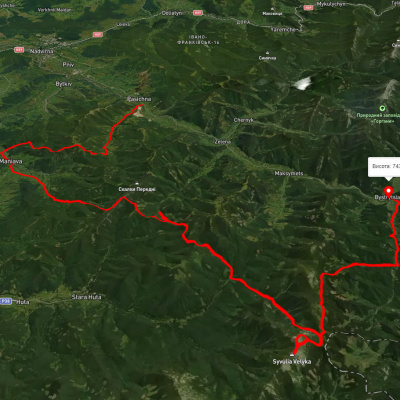
с. Пасічна, через с. Манява, Манявський вдсп., г. Велика Сивуля до с. Бистриця
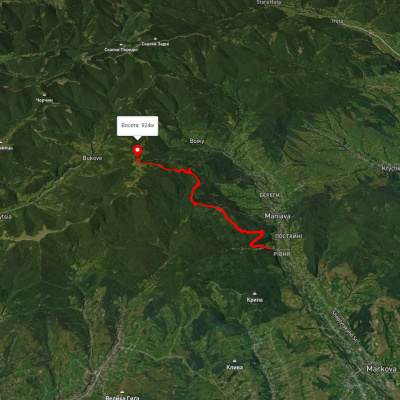
с. Манява - пол. Монастирецька
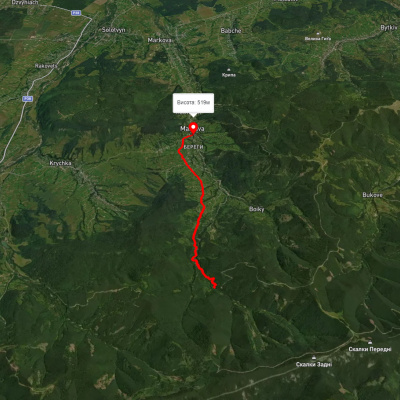
с. Манява - вдсп. Манявський

с. Гута - с. Пасічна

